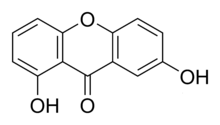Euxanthone
 | |
| Names | |
|---|---|
| IUPAC name
1,7-Dihydroxyxanthen-9-one | |
Other names
| |
| Identifiers | |
3D model (JSmol) |
|
| 3DMet | B03583 |
| 207044 | |
| ChEBI | |
| ChEMBL | |
| ChemSpider | |
| KEGG | |
PubChem CID |
|
| |
| |
| Properties | |
| C13H8O4 | |
| Molar mass | 228.20 g·mol−1 |
| Melting point | 240 °C (464 °F; 513 K) |
Except where otherwise noted, data are given for materials in their standard state (at 25 °C [77 °F], 100 kPa). | |
| Infobox references | |
Euxanthone is a naturally occurring xanthonoid, an organic compound with the molecular formula C13H8O4. It can be synthesized from gentisic acid, β-resorcylic acid, and acetic anhydride.[1] It occurs naturally in many plant species. Commercial production is from purified root extract of Polygala tenuifolia.[2] It has been investigated for bioactive properties.[3][4]
References
- ↑ Baer, N.S.; et al. "Indian Yellow". Artists' pigments : a handbook of their history and characteristics. Washington: National Gallery of Art. pp. 25 Fig. 4D Synthesis of euxanthone.
- ↑ "Polygala tenuifolia Willd. -- ChemFaces". www.chemfaces.com. Retrieved 2018-07-11.
- ↑ Naidu, M.; Kuan, C.-Y.K.; Lo, W.-L.; Raza, M.; Tolkovsky, A.; Mak, N.-K.; Wong, R.N.-S.; Keynes, R. (2007). "Analysis of the action of euxanthone, a plant-derived compound that stimulates neurite outgrowth". Neuroscience. 148 (4): 915–924. doi:10.1016/j.neuroscience.2007.07.037. ISSN 0306-4522.
- ↑ Câmara, D.V.; Lemos, V.S.; Santos, M.H.; Nagem, T.J.; Cortes, S.F. (2010). "Mechanism of the vasodilator effect of Euxanthone in rat small mesenteric arteries". Phytomedicine. 17 (8–9): 690–692. doi:10.1016/j.phymed.2009.12.003. ISSN 0944-7113.
This article is issued from
Wikipedia.
The text is licensed under Creative Commons - Attribution - Sharealike.
Additional terms may apply for the media files.